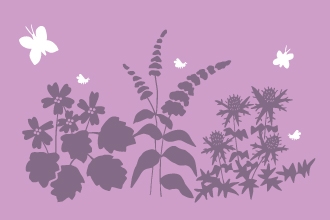
Peacock butterfly by Terry Whittaker/2020VISION
How to make a wildlife-friendly garden
Welcome to BBOWT's video series about helping wildlife in Berks, Bucks and Oxon.
Have you got a question you'd like Ben to answer about wildlife gardening, or suggestions for future topics? Pop them in the comments or share them with us on social media, tagging @BBOWT, and we'll try to get them all answered in future videos.
How to help hedgehogs
Hedgehogs are without doubt one of the nation’s favourite mammals, but they are in decline. Ben’s here to share tips on how to help them thrive.
Make Your Garden Bat Friendly (https://youtu.be/4KmjmEArBpw)
Make Your Garden Bat Friendly
Make your garden bat friendly
On a late summer’s evening there’s nothing quite as entertaining as watching the bats come out to swish and swoop on their hunt for food. They’re fascinating creatures, but they need our help. Here’s how you can do your bit.
Wiggly wonders: Look after our worms (https://youtu.be/vvQbzmW9o0o)
Wiggly wonders: Look after our worms
How to help worms
Worms are an easily overlooked part of the garden – they’re underground after all. But a garden with a healthy worm population is the starting point to one that’s alive with wildlife! Get lots more ideas to help worms in our free booklet.
Flower power: Grow a miniature meadow (https://youtu.be/2VWdJTJKvIE)
Flower power: Grow a miniature meadow
Make a mini meadow
Meadows are truly special places, full of stunning wild flowers and alive with the colour and industry of insects such as butterflies. So why not make a miniature meadow in your garden!
Check in time: Make a bug hotel (https://youtu.be/uyZaCc0Heks)
Check in time: Make a bug hotel
How to make a bug hotel
Did you know that the average garden has more than 2,000 different species of insects. That’s incredible isn’t it! Why not encourage even more of them with a beautiful bug hotel. Ben's here to show you how to make one, from a simple bundle of canes to a 5* mansion!
Patio gardens for wildlife (https://youtu.be/TZsJweXV2hw)
Patio gardens for wildlife
Perfect patios for wildlife
Turn your patio into a haven for wildlife whatever its size with Ben's top tips for containers, hanging baskets, climbers, and even a small pond.
For peat's sake - Go peat free in the garden (https://youtu.be/biMaJSx5TY8)
Go peat free in the garden
Go peat free
Our gardens have an important role in the fight against the climate crisis. You can help preserve vital peatland by going peat free in your garden. Ben's here to show you just how easy it is.
Build a garden pond (https://youtu.be/NPwEvxYhfSg)
Create a wildlife pond
How to make a garden pond
Ponds are one of the best things for wildlife that you can add to your garden. Ben shows you how simple it is to make your own pond, and shares some tips about great plants to add.
A great project for the weekend, and you'll be surprised how quickly the wildlife will move in!
Get step by step instructions and lists of great pond plants
If you've got a small garden or just a patio, why not build a mini pond!
Make a simple log pile for wildlife (https://youtu.be/z4uyHFrR8AY)
Make a simple log pile for wildlife
Make a log pile for wildlife
A simple log pile is a great addition to your garden for all sorts of creatures. Ben shows you how to create one.
Make your garden wilder (https://youtu.be/DeeIdYUJRf4)
Make your garden wilder for wildlife
Grow wilder for wildlife
Making part of your garden wilder for wildlife doesn't mean it needs to be messy, as Ben explains!
Natural pest control (https://youtu.be/ztAE-p-CjY0)
Natural pest control
Natural pest control
Work with nature to get rid of unwanted creatures from your garden with these simple tips from Ben.
Feeding the birds in spring (https://youtu.be/AQjnxx8Y4qw)
Feeding the birds in spring
Feeding garden birds
Our garden birds have been giving us so much pleasure at the moment, but what should we be feeding them while they raise their families? Ben shares some top tips in his next video.
Create a buzz - flowers for bees and butterflies (https://youtu.be/NJVu4lxksgc)
Create a buzz - flowers for bees and butterflies
Plants for pollinators
Welcome to the first in our new series of wildlife gardening videos with Ben. In our first episode, we're looking at the best plants to grow so that your garden provides bees and butterflies with pollen and nectar all year round.
Receive the latest news from BBOWT, more tips about how you can help wildlife, plus information on how you can get involved with our newsletter.
Find more ways to help wildlife

How to have an eco-Christmas
Whether you celebrate a big family Christmas, or you just give out a few cards to your friends and neighbours to wish them a happy time…

How to start a wildlife garden from scratch
Use the blank canvas of your garden to make a home for wildlife.

How to have a plastic- free Halloween
Halloween is often a great time for spooky family fun, but unfortunately it is often full of plastic.

How to build a bird box
With natural nesting sites in decline, adding a nestbox to your garden can make all the difference to your local birds.

How to build a bug mansion
Build your own bug mansion and attract a multitude of creepy crawlies to your garden.

The best plants for bees and pollinators
Set up a ‘nectar café’ by planting flowers for pollinating insects like bees and butterflies
